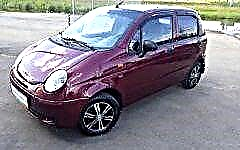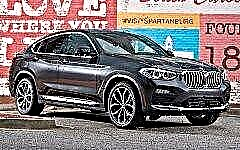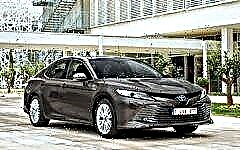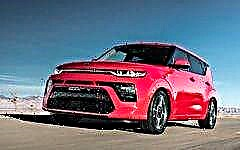

The content of the article:
- A little about cars in general
- Common between Honda and Toyota
- Compare class C: Honda Civic or Toyota Corolla
- Compare class D: Toyota Camry and Honda Accord
- Compare Toyota RAV4 and Honda CR-V crossovers
- Compare Toyota Prius and Honda Civic Hybrid
Japanese cars have long and confidently conquered the world, having firmly established themselves, including in the Russian market. They are favorably distinguished by an adequate combination of price and quality, and the repair of "Japanese women" is more budgetary than their European counterparts.
Of the many Japanese firms, we propose to consider for comparison Toyota and Honda cars, which are found in huge numbers on the roads of Russia.
A little about cars in general

Honda
This automaker does not have a long history, although it goes back over 80 years. In addition to cars, the production produces very popular motorcycles, airplanes and developments in the field of robotics.
According to the owners' reviews and the assessments of auto experts, Honda are among the reliable cars that do not present unpleasant surprises. It is considered that Honda equips its cars with the best engines on the world market and is a symbol of Japanese reliability.
The suspension of cars is multi-link, almost eternal. Any model of the car can be made in any configuration and equipped with a motor according to capabilities, finances and wishes. Cars look prestigious and, in fact, they are.
The most famous for this brand are "sports orientation". Actually, these cars, in essence, are not racing, but they have the best engine in their class in comparison with others, hence the passion to drive them. The volume of the engines does not exceed 2 liters, but due to special engineering developments, the power of the machine increases significantly.
The disadvantages are the excessive cost of maintenance and the "sophistication" of electronic brains, which complicates repairs. There is also weakness in damping - the road bumps are felt more strongly on the Honda.
Toyota
A well-known Japanese car manufacturer that has been on the market 20 years longer than Honda. Since 2012, it has firmly held its leading position as the world's largest automaker. During 2012-2015, it was listed as the most expensive car brand.
Produce trucks and passenger cars and buses. On the territory of Russia since 2005 near St. Petersburg in the village. A plant has been built in Shushary, where machines are assembled for use in the Russian Federation.
The brand is famous for its conservatism, preferring to produce cars that do not differ in configuration and quality at different factories in different countries. Reliability comes first, and design sophistication fade into the background. In a way, it is the Japanese analogue of Zhiguli, when with a minimum of frills, a small choice between a diesel and a gasoline engine, an affordable and inexpensive service with cheap components and spare parts is offered.
At the same time, the Toyota line allows you to choose a car for a long time and with taste - the model range is very wide. Here you can choose a small car and a truck, a convertible and a sedan, a cheap and expensive car equipped with a gasoline, diesel or hybrid engine.
Auto parts are easy to find, but often they are made in Chinese factories, and the quality is appropriate for them. Native Japanese spare parts need to be looked for.
Common between Honda and Toyota

Honda and Toyota are two Japanese automakers that prioritize product reliability.
The cars are quite "smooth" in operation, each has its own subtleties, but in general, both brands are distinguished by their durability and practicality in use. They serve for a long time, age beautifully, without becoming a pile of junk on wheels.
Despite the price difference, on average, Honda is more expensive (including repairs), but its need for spare parts is much lower, and the lower Toyota price is compensated by more frequent, albeit inexpensive, repairs.
Any Japanese product is about the same in quality. In the lineup, each has its own successes and shortcomings. So, Toyota's naturally aspirated engines of the C series (diesel) are almost problem-free, and the same turbocharged 2C-T engine often flies.
If we talk about the smoothness of the chassis and design features of the suspension, do not discount the difference in handling. Honda has the handling of a sports car, its suspension should look stiffer by default, and Toyota is more of a sedate car that moves smoother and softer.
These are not advantages or disadvantages, this is the difference in the buying needs of drivers who value different speed modes, have different driving habits and purchase cars for different purposes. The interior trim in general for the Japanese car industry in one class of cars is similar in quality. Therefore, it is better to compare specific models of one segment than all the cars of one manufacturer in bulk.
Compare class C: Honda Civic or Toyota Corolla

In the photo: Honda Civic and Toyota Corolla
These two "Japanese" sedans are very economical, reliable, well equipped, and relatively inexpensive. Meanwhile, there are differences between them. Both run on gasoline, equipped with a five-speed automatic transmission, front-wheel drive.
The engine for the Civic is 140 hp, fuel consumption is 6.5 liters per 100 km. For the Corolla, the engine is rated at 132 hp and has a fuel consumption of 9 liters.
Differences:
- The strongest part of the Civic is the chassis. The engine is reliable and time-tested, without ultra-modern "bells and whistles". Despite the slightly larger "horse" volume, it consumes significantly less fuel.
- The Corolla has a good engine and chassis, is easy to maintain, but has paint problems.
- The Civic, unlike the Corolla, can only run on pure, quality gasoline. Any impurities drastically reduce the engine's performance.
- The Corolla has a taller body, while the Civic has a longer body.
- The Corolla's ground clearance is slightly higher, but the trunk is larger for the Civic.
- According to the reviews of "civic owners" the car is of higher quality, more reliable and more presentable. "Koroll Owners" note the low cost of repairs.
- With the same external technical parameters, the Civic is cheaper.
- The Corolla offers greater comfort over long distances.
Both cars are not bad, when choosing, one should rather take into account the driving style, the budget for further use after purchase, the size of the wallet.
For lovers of powerful, fast, maneuverable, but at the same time budget cars with a small starting volume of finance, when buying, it is better to opt for the Honda Civic. If ride comfort is important first of all and there is no constraint in funds, then it is better to choose Toyota Corolla.
Compare class D: Toyota Camry and Honda Accord

In the photo: Toyota Camry and Honda Accord
Both business class cars are designed for quiet driving of calm people who value simple handling, spacious interior, predictability of the car's behavior on the road and reliability. They are popular and widespread in all countries.
We are considering models with four-cylinder petrol engines:
Camry has a 2.5-liter engine with a capacity of 181 hp, an automatic transmission with a 6-speed transmission; fuel consumption in the "city" mode is 11 liters per 100 km, in the "highway" mode - 5, 9 liters.
Accord equipped with a 2.4 liter 180 hp engine, with a CME variator; fuel consumption in the "city" mode is 11.7 liters per 100 km, in the "highway" mode - 6.2 liters.
Difference:
- Camry loses to Accord in appearance, it is more simple.
- The Accord consumes a little more fuel according to the "official version", but on test drives on the track, the Camry ate more than its "opponent".
- The new Accord CVT is quiet, confident and the best on the market today.
- Camry can be switched to "manual" driving mode, allowing the driver to determine the dynamics of the movement.
- On straight sections of the track, the Accord's dynamics are better, the speed picks up faster.
- The Camry's interior looks more stylish and the finishes are better.But the Accord interface is a little more convenient.
- The front seats in the Accord are more comfortable, with more rear space for the same size of the cabin.
Output: both cars are equally interesting, comfortable, even when traveling long distances. But despite the simpler look, the Camry feels a little better for the driver.
Compare Toyota RAV4 and Honda CR-V crossovers

In the photo: Toyota RAV4 vs Honda CR-V
Both cars are sort of "stars" of the crossover class, with a lot of fans. The appearance of the cars is interesting. Restyling the RAV4 from 2016 gave the car a memorable look. The new CR-V model also boasts a successful update - the exterior of the car has become more brutal and modern.
RAV4 equipped with a 2.5 liter 180 hp engine. with 6-speed transmission. Average fuel consumption is 12 liters per 100 km.
CR-V equipped with a 2.4-liter engine with a capacity of 180 hp, with a five-speed "automatic". Fuel consumption sometimes reaches 15 liters per 100 km.
Difference:
- The appearance of the RAV4 loses against the background of the more modern CR-V, in the design of which many small but striking elements have been introduced.
- The RAV4 is equipped with three types of engines (petrol 2 and 2.5 liters, equipped with a choice of a variator or 6-speed mechanics, versions of the car - front- or all-wheel drive; 2.2-liter diesel with a 6-speed automatic with a 4x4 formula). CR-V offers 2 and 2.4 liter motors with CVT and all-wheel drive.
- The ground clearance of the CR-V (208 mm) is greater than that of the RAV4 (190 mm), but the sharp, sporty dynamics of the Honda has diminished, while the Toyota still has a “soft” suspension when driving.
- The trunk volume of the RAV4 is 50 liters more.
- In the CR-V, the rear seats fold down automatically when a handle is pressed in the cabin, but in the usual case, three people in the back seat can be narrow.
- The ergonomics of the RAV4 are not bad in general, the car is comfortable and cozy, the lateral support of the seats is especially pleasant, but in the CR-V the interior is a little more elegant.
- Passengers in the rear seats in the CR-V are more comfortable, as there is more space by 60 cm.
- The RAV4 has a very competent all-round view system with information broadcast on the screen from four cameras, including the front wheels. To this luxury we would add the cleaning of the front camera, which gets smudged after a couple of minutes - and this "chip" would not have been worth it. The CR-V has only one camera that broadcasts the road behind the car.
- Even the top version of the CR-V is clearly inferior to the average RAV4 in adapting cruise control, stabilization and retention systems, and blind spot control.
- With an equal engine size and power, the price difference reaches half a million in favor of the CR-V.
Both cars are excellently built, reliable in operation, good road holding and cornering, although the CR-V clearly wins in external design, but loses in high cost.
Compare Toyota Prius and Honda Civic Hybrid

Photo: Toyota Prius vs Honda Civic Hybrid
The hybrid versions of the Prius and Civic are very different from each other. In general, they have petrol engines, hybrid drives, chassis and electrics - everything is reliable. On both cars, high-voltage batteries last a long time if the car is driven frequently.
- By the type of construction, the Civic is much closer to the usual cars. If you look under the hood of the Prius, it will be immediately clear that nothing is clear, while the engine compartment of the Civic is almost the same, with the difference in the presence of orange-braided wires.
- The operation of these machines also looks different. The Prius is capable of driving an electric motor for several kilometers, and a traditional motor can either assist the electric motor or charge the traction battery. The Civic, on the other hand, is powered by a gasoline engine, and the electric "brother" can help a little, and also act as a generator and battery charging. If the electric motor is turned off, the Civic will go torn, but the Prius simply will not be able to start.
- In Prius operation, coordination between the electric and gasoline engines is important enough to transmit torque to the wheels. For the Civic Hybrid, a V-belt variator was invented, a good one, but it wears out very quickly. The oil must be changed often, without waiting for the prescribed 20,000 km.
The Toyota Hybrid is definitely better with no options. In addition, the Civic Hybrid eats a lot of gasoline.
Conclusion
Choosing a car is not easy. Consider your needs, driving style, financial capabilities. And then go on a test ride that will help you make the right decision!











